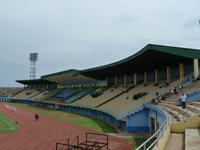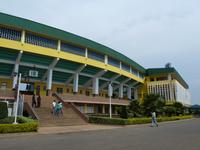Stade Amahoro – until 2022
| Capacity | 25 000 |
|---|---|
| Country | Rwanda |
| City | Kigali |
| Clubs | AS Kigali, Rayon Sports FC, Nyanza FC, Kiyovu SA, La Jeunesse FC |
| Retire year | 2022 |
| Inauguration | 1986 |
| Construction | 03/1984 – 01/1989 |
| Renovations | 2011–2016 |
| Contractor | China Civil Engineering Construction Corporation |
Advertisement
Stade Amahoro – historical stadium description
Rwanda's national stadium, dubbed the “Peace Stadium” (Amahoro in the Kinyarwanda language means peace), was built in the 1980s with the help of the Chinese government. Construction work was carried out between March 1984 and January 1989 (the opening took place as early as 1986), and the contractor was the China Civil Engineering Construction Corporation (CCECC). The stadium hosted matches of the Rwandan national team and games of local football clubs, as well as athletic competitions or concerts.
The stadium became famous as a shelter for some 12,000 people, mostly representatives of the Tutsi tribe, during the 1994 Rwandan genocide. UN soldiers were there to safeguard their stay there, but the situation was critical. One of the peacekeepers described his view of the place in 1994 in his book: “Twelve thousand people trying to live in here. So you get this latent smoke that hangs in here. All you see is people and clothes and so the place looks absolutely, totally out of control. It became, in probably the most pejorative way, something like a concentration camp. We were out there protecting them, but while we were out there, they were inside dying. And the stench, the stench was so powerful you actually had to force yourself not to puke or anything”.
The stadium had an athletics track with a ring of stands around it. Only the main stand was equipped with a roof and a small number of seats. The capacity of the facility was about 25,000 spectators. Four floodlight masts stood in the corners, and a video screen was placed on the southern curve. In 2011–2016 the stadium was renovated.
In 2022–2024, a comprehensive expansion of the stadium was carried out. The stands were enlarged by a second tier and equipped with seats and a new canopy. The stadium was significantly upgraded and adapted to today's high standards, and its capacity increased to 45,000 spectators. The expanded Stade Amahoro was re-inaugurated on July 1, 2024.
Advertisement
Pictures
2011

03.09.2011 © Frank Jasperneite 
03.09.2011 © Frank Jasperneite 
03.09.2011 © Frank Jasperneite 
03.09.2011 © Frank Jasperneite 
03.09.2011 © Frank Jasperneite 
03.09.2011 © Frank Jasperneite 
03.09.2011 © Frank Jasperneite 
03.09.2011 © Frank Jasperneite 
03.09.2011 © Frank Jasperneite 
03.09.2011 © Frank Jasperneite 
03.09.2011 © Frank Jasperneite 
03.09.2011 © Frank Jasperneite
Related news
2024
2014
-

Africa: Rwanda’s dream stadium must wait
It would have been a gem of the 2016 Africa Nations Championships. But a brand new 40,000-seater was put on hold as delivery in time for the tournament proved impossible.
-

Africa: Wails, sobs and bodies across the stadium
This was only a re-enactment, but one that horrificly resembled reality from 20 years back. Rwanda yesterday commemorated those who perished in the 1994 genocide.
 StadiumDB
StadiumDB